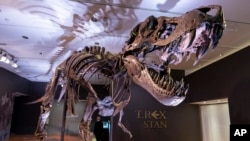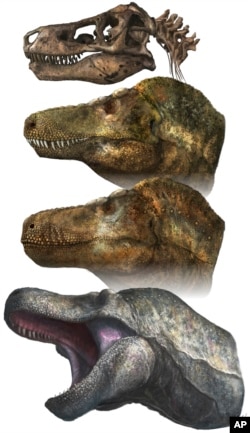The Tyrannosaurus rex, or T. rex, is a dinosaur that lived from the late Jurassic Period, about 150 million years ago, to the end of the Cretaceous Period, about 65 million years ago.
Most artistic representations of the animal show its large, sharp teeth sticking out of its mouth, always visible. The T. rex model of the Jurassic Park movie series is an example.
But scientists now say the dino probably did not look like that.
Tyrannosaurus rex belongs to a group of meat-eating dinosaurs called theropods. A study published Thursday in the journal Science found the teeth on T. rex and other big theropods were likely covered by thick, scaly lips. Lips are the soft parts that surround the mouth.
The scientists found that the dinosaur’s teeth did not stick out when its mouth was closed. They added that even in a wide open bite, only a small area of its teeth would show.
The research is the latest in a long debate over how dinosaur mouths really looked.
Recent images show big teeth extending out of the dinosaurs’ jaws, even when closed. Some people thought the dinosaurs’ teeth were just too big to fit in their mouth, said study writer Thomas Cullen. He is a paleontologist at Auburn University in Alabama.
When researchers compared skulls from dinosaurs and living reptiles, though, they found this was not the case. Cullen said some large monitor lizards actually have bigger teeth than T. rex compared to their head size, and can still fit them under a set of scaly lips.
The scientists also found signs of wear on the surface of the teeth that suggested they were hidden from view.
Reptiles without such lip protection, like crocodiles, experience wear on their teeth quickly.
But when researchers studied a tooth from Daspletosaurs, a T. rex relative, they found it was in good condition and it did not show similar signs of wear.
Thomas Holtz is a dinosaur expert with the University of Maryland. He said with this evidence and other information from the build of the dinosaur, the study makes a good case for lipped tyrannosaurs. The lips would be thin and scaly, he added. The scientist was not involved with the study.
It is not the first time the representation of dinosaurs has been called into question. Most of what science learns about dinosaurs comes from their bones. It is harder to get clear answers about soft tissues, like skin. Remains of soft tissues disappear more quickly.
Adding lips to artistic representations may make dinosaurs look a little less terrifying, but it also makes them feel more realistic, Mark Witton said. He is a paeloartist at England's University of Portsmouth and another writer of the study.
“You don’t really see a monster,” he said. “You see an animal.”
I’m Gregory Stachel.
Marcia Dunn reported this story for The Associated Press. Gregory Stachel adapted it for VOA Learning English.
_______________________________________________________________
Words in This Story
visible – n. able to be seen; exposed to view
scale – n. one of many small thin plates that cover the bodies of some animals (such as fish or snakes)
jaws – n. either one of the two bones of the face where teeth grow
paleontology – n. the science that deals with the fossils of animals and plants that lived very long ago especially in the time of dinosaurs
skull – n. the structure of bones that form the head and face of a person or animal
monster – n. a strange or horrible imaginary creature
________________________________________________________________
What do you think of this story?
We want to hear from you. We have a new comment system. Here is how it works:
- Write your comment in the box.
- Under the box, you can see four images for social media accounts. They are for Disqus, Facebook, Twitter and Google.
- Click on one image and a box appears. Enter the login for your social media account. Or you may create one on the Disqus system. It is the blue circle with “D” on it. It is free.
Each time you return to comment on the Learning English site, you can use your account and see your comments and replies to them. Our comment policy is here.










Forum